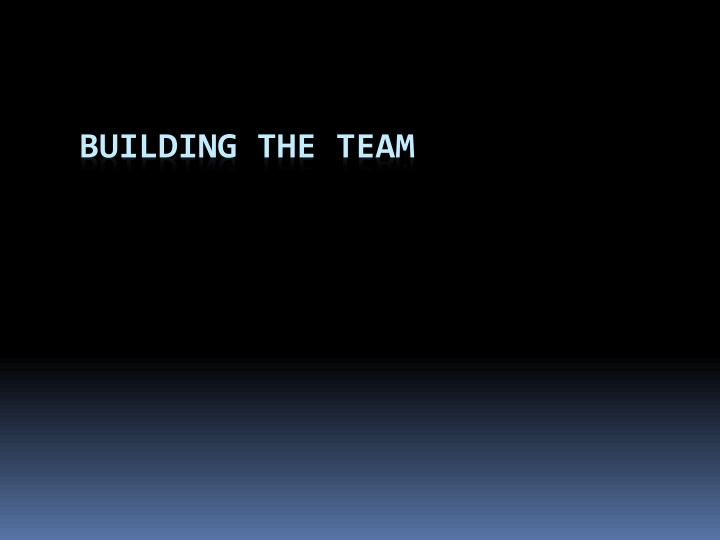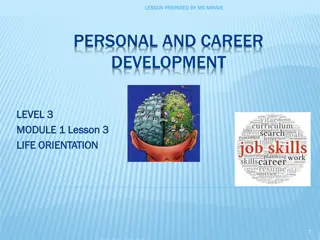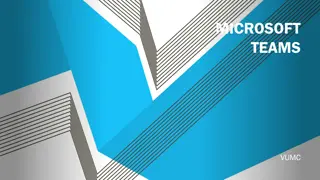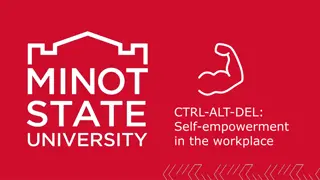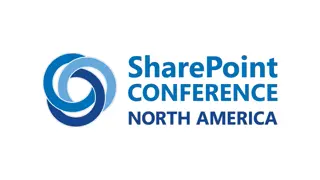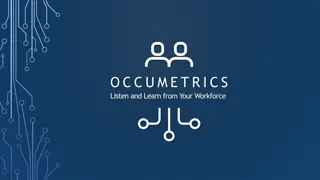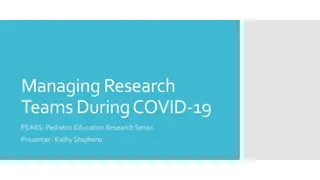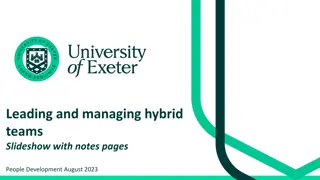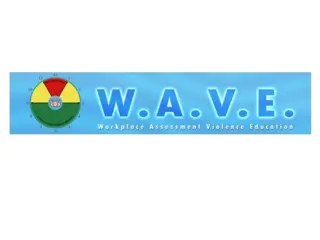Teams in the Workplace
Teams in the workplace are essential for achieving common goals and fostering collaboration. Learn about the types of teams, advantages, challenges, and how to maximize team performance. Explore the dynamics of informal groups and the strategies to minimize social loafing.
Download Presentation

Please find below an Image/Link to download the presentation.
The content on the website is provided AS IS for your information and personal use only. It may not be sold, licensed, or shared on other websites without obtaining consent from the author.If you encounter any issues during the download, it is possible that the publisher has removed the file from their server.
You are allowed to download the files provided on this website for personal or commercial use, subject to the condition that they are used lawfully. All files are the property of their respective owners.
The content on the website is provided AS IS for your information and personal use only. It may not be sold, licensed, or shared on other websites without obtaining consent from the author.
E N D
Presentation Transcript
What are Teams? Groups of two or more people Exist to fulfill a purpose Interdependent --interact and influence each other Mutually accountable for achieving common goals Perceive themselves as a social entity
Team as a collection of individuals
Team as a collection of individuals with a shared common vision Alignment of purpose
Groups versus Teams All teams are groups Some groups are just people assembled together Teams have task interdependence whereas some groups do not (e.g., group of employees enjoying lunch together)
Many Types of Teams Departmental teams Production/service/ leadership teams Self-directed teams Advisory teams Skunkworks Task force (project) teams Virtual teams Communities of practice
Why Informal Groups Exist 1. Innate drive to bond 2. Social identity We define ourselves by group memberships 3. Goal accomplishment 4. Emotional support
Advantages of Teams Compared with individuals working alone, teams tend to: Make better decisions Make better products and services due to more knowledge and expertise Increase employee engagement
The Trouble With Teams Individuals better/faster on some tasks Process losses - cost of developing and maintaining teams Brooks Law -- more delays when adding members to a team already behind schedule Social loafing Occurs when individuals exert less effort when working in groups than alone
How to Minimize Social Loafing Make individual performance more visible Form smaller teams Specialize tasks Measure individual performance Increase employee motivation Increase job enrichment Select motivated employees
TEAM EFFECTIVENESS MODEL AND COMPONENTS
Team Effectiveness Model Team Design Team Effectiveness Task characteristics Team size Achieve organizational goals Team composition Organizational and Team Satisfy member needs Environment Team Processes Maintain team survival Team development Team norms Team cohesiveness Team trust
Teams Task and Size Task characteristics Better when tasks are clear, easy to implement Share common inputs, processes, or outcomes Task interdependence Team size Smaller teams are better But large enough to accomplish task
Levels of Task Interdependence High A Reciprocal B C A B C Sequential Resource Pooled A B C Low
Team Composition Effective team members must be willing and able to work on the team Effective team members are good at the 5 C s: Cooperating Coordinating Communicating Comforting (psych support) Conflict resolving Team diversity Homogeneous or heterogeneous, depending on task requirements
Team Development Team development involves: Interpersonal knowledge and trust Understand and agree on roles Discover appropriate behaviors Learn to coordinate with each other Develop team mental models
Stages of Team Development Performing Norming Storming Existing teams might regress back to an earlier stage of development Adjourning Forming
Team Norms Informal rules and shared expectations team establishes to regulate member behaviors Norms develop through: Initial team experiences Critical events in team s history Experience/values members bring to the team
Changing Team Norms Introduce norms when forming teams Select members with preferred values Discuss counter-productive norms Reward behaviors representing desired norms Disband teams with dysfunctional norms
Team Cohesion The degree of attraction people feel toward the team and their motivation to remain members Calculative -- members believe the team will fulfill goals and needs Emotional -- team is part of person s social identity
Influences on Team Cohesion Member similarity Similarity-attraction effect Some forms of diversity have less effect Team size Smaller teams more cohesive Member interaction Regular interaction increases cohesion Calls for tasks with high interdependence
Influences on Team Cohesion (con t) Somewhat difficult entry Team eliteness increases cohesion But lower cohesion with severe initiation Team success Successful teams fulfill member needs Success increases social identity with team External challenges Challenges increase cohesion when not overwhelming
Team Cohesiveness Outcomes 1. Want to remain members 2. Willing to share information 3. Strong interpersonal bonds 4. Resolve conflict effectively 5. Better interpersonal relationships
Cohesiveness and Performance Moderately high task performance Team Norms Support Goals High task performance Moderately low task performance Team Norms Oppose Goals Low task performance Low Team Cohesiveness High Team Cohesiveness
Trust Defined A psychological state comprising the intention to accept vulnerability based upon positive expectations of the intent or behavior of another person
Three Levels of Trust High Identity-based Trust Knowledge-based Trust Calculus-based Trust Low
Three Levels of Trust (cont) Calculus-based trust Based on deterrence Fragile, limited, dependent on punishment Knowledge-based trust Based on predictability and competence Fairly robust, develops over time Identification-based trust Based on common mental models and values Increases with person s social identity with team
SELF-DIRECTED TEAMS AND VIRTUAL TEAMS
Self-Directed Team Attributes Formal groups that complete an entire piece of work requiring several interdependent tasks and have substantial autonomy over the execution of these tasks. 1. Complete an entire piece of work requiring interdependent tasks 2. Substantial autonomy over execution of the team s tasks
Self-Directed Team Success Factors Responsible for entire work process High interdependence within the team Low interdependence with other teams Autonomy to organize and coordinate work Technology supports team communication/coordination
Virtual Teams Teams whose members operate across space, time, and organizational boundaries and are linked through information technologies to achieve organizational tasks Increasingly possible because of: Information technologies Knowledge-based work Increasingly necessary because of: Knowledge management Globalization
Virtual Team Success Factors Member characteristics Technology savvy Self-leadership skills Emotional intelligence Flexible use of communication technologies Opportunities to meet face-to-face
TEAM DECISION MAKING
Team Decision Making Constraints Time constraints Time to organize/coordinate Production blocking Evaluation apprehension Belief that other team members are silently evaluating you Conformity to peer pressure Suppressing opinions that oppose team norms Groupthink Tendency in highly cohesive teams to value consensus at the price of decision quality Concept is losing favor -- need to consider specific features instead (e.g. overconfidence)
General Guidelines for Team Decisions Team norms should encourage critical thinking Sufficient team diversity Ensure neither leader nor any member dominates Maintain optimal team size Introduce effective team structures
Constructive Conflict Occurs when team members debate their different perceptions about an issue in a way that keeps the conflict focused on the task rather than people. Problem: constructive conflict easily slides into personal attacks
Rules of Brainstorming 1. Speak freely 2. Don t criticize 3. Provide as many ideas as possible 4. Build on others ideas
Evaluating Brainstorming Strengths Produces more innovative ideas Strengthens decision acceptance and team cohesiveness Sharing positive emotions encourages creativity Higher customer satisfaction if clients participate Weaknesses Production blocking still exists Evaluation apprehension exists in many groups Fewer ideas generated than when people work alone
Electronic Brainstorming Participants share ideas using software Usually in the same room, but may be dispersed Question posted, then participants submit their ideas or comments on computer Comments/ideas appear anonymously on computer screens or at front of room
Evaluating Electronic Brainstorming Strengths Less production blocking Less evaluation apprehension More creative synergy More satisfaction with process Weaknesses Too structured Technology-bound Candid feedback is threatening Not applicable to all decisions
Nominal Group Technique Individual Activity Team Activity Individual Activity Possible solutions described to others Write down possible solutions Vote on solutions presented Describe problem
